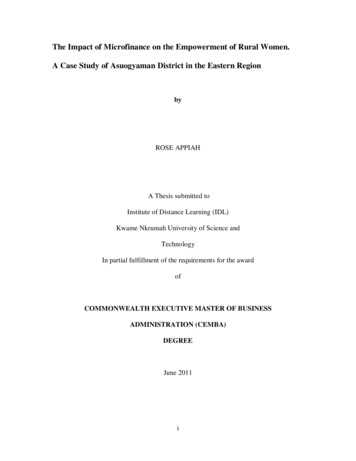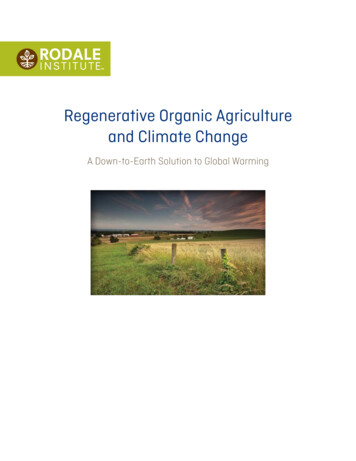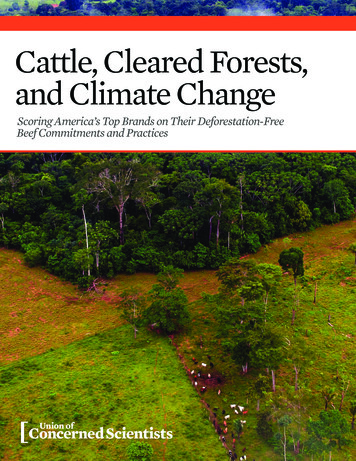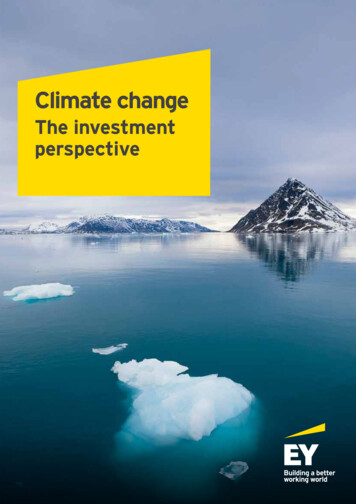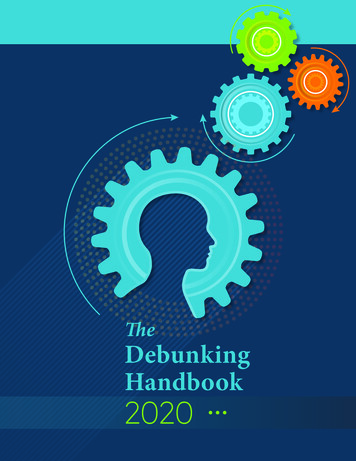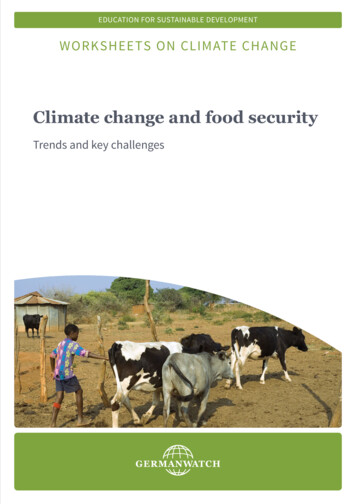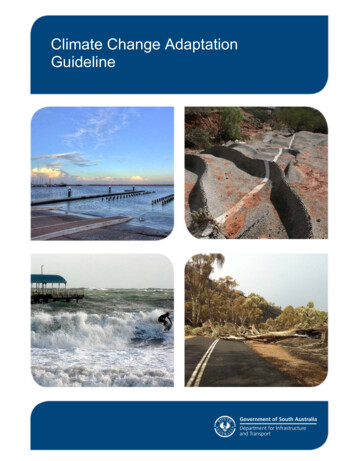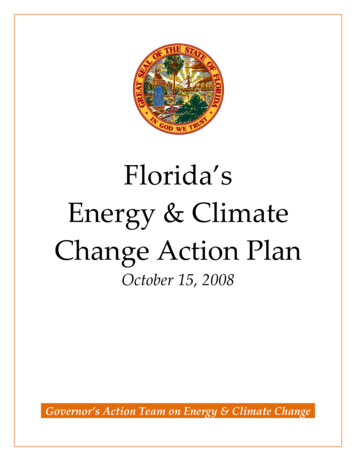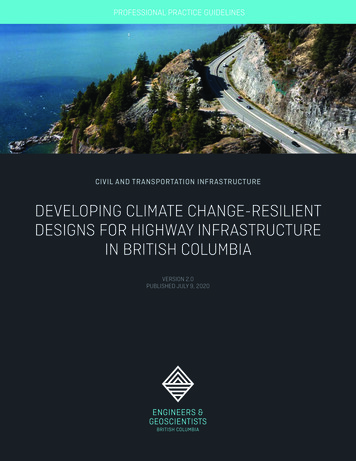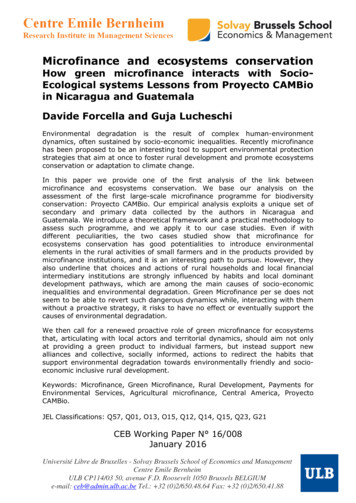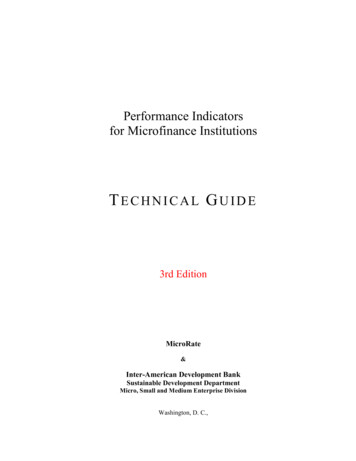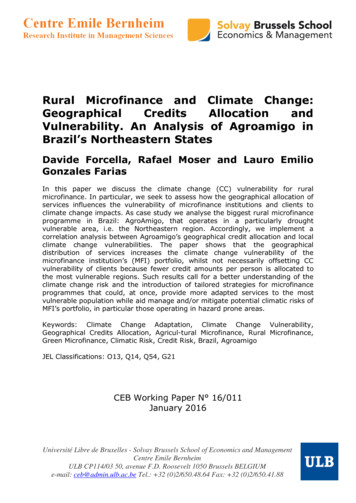
Transcription
Rural Microfinance and Climate ty. An Analysis of Agroamigo inBrazil’s Northeastern StatesDavide Forcella, Rafael Moser and Lauro EmilioGonzales FariasIn this paper we discuss the climate change (CC) vulnerability for ruralmicrofinance. In particular, we seek to assess how the geographical allocation ofservices influences the vulnerability of microfinance institutions and clients toclimate change impacts. As case study we analyse the biggest rural microfinanceprogramme in Brazil: AgroAmigo, that operates in a particularly droughtvulnerable area, i.e. the Northeastern region. Accordingly, we implement acorrelation analysis between Agroamigo’s geographical credit allocation and localclimate change vulnerabilities. The paper shows that the geographicaldistribution of services increases the climate change vulnerability of themicrofinance institution’s (MFI) portfolio, whilst not necessarily offsetting CCvulnerability of clients because fewer credit amounts per person is allocated tothe most vulnerable regions. Such results call for a better understanding of theclimate change risk and the introduction of tailored strategies for microfinanceprogrammes that could, at once, provide more adapted services to the mostvulnerable population while aid manage and/or mitigate potential climatic risks ofMFI’s portfolio, in particular those operating in hazard prone areas.Keywords: Climate Change Adaptation, Climate Change Vulnerability,Geographical Credits Allocation, Agricul-tural Microfinance, Rural Microfinance,Green Microfinance, Climatic Risk, Credit Risk, Brazil, AgroamigoJEL Classifications: O13, Q14, Q54, G21CEB Working Paper N 16/011January 2016Université Libre de Bruxelles - Solvay Brussels School of Economics and ManagementCentre Emile BernheimULB CP114/03 50, avenue F.D. Roosevelt 1050 Brussels BELGIUMe-mail: ceb@admin.ulb.ac.be Tel.: 32 (0)2/650.48.64 Fax: 32 (0)2/650.41.88
Title:Rural Microfinance and Climate Change: Geographical Credits Allocation and Vulnerability.An Analysis of Agroamigo in Brazil’s Northeastern States!Authors:Forcella, Davide, CERMi, ULBMoser, Rafael; FGV, UNDPLauro Gonzalez; FGV!Abstract:In this paper we discuss the climate change (CC) vulnerability for rural microfinance. In particular,we seek to assess how the geographical allocation of services influences the vulnerability ofmicrofinance institutions and clients to climate change impacts. As case study we analyse thebiggest rural microfinance programme in Brazil: AgroAmigo, that operates in a particularly droughtvulnerable area, i.e. the Northeastern region. Accordingly, we implement a correlation analysisbetween Agroamigo’s geographical credit allocation and local climate change vulnerabilities. Thepaper shows that the geographical distribution of services increases the climate change vulnerabilityof the microfinance institution’s (MFI) portfolio, whilst not necessarily offsetting CC vulnerabilityof clients because fewer credit amounts per person is allocated to the most vulnerable regions. Suchresults call for a better understanding of the climate change risk and the introduction of tailoredstrategies for microfinance programmes that could, at once, provide more adapted services to themost vulnerable population while aid manage and/or mitigate potential climatic risks of MFI’sportfolio, in particular those operating in hazard prone areas.!!KeyWords: Climate Change Adaptation, Climate Change Vulnerability, Geographical Credits Allocation,Agricultural Microfinance, Rural Microfinance, Green Microfinance, Climatic Risk, Credit Risk, Brazil,Agroamigo!JEL Codes: O13, Q14, Q54, G21!!!!!
!INTRODUCTION!There are increasing scientific evidences that the Earth’s Climate is changing and that the main driver of this change are the human activities (IPCC, 2014a). Mean surface air temperature is likely toincrease more than 1.5 C by the end of the century (compared to the reference period 1850-1900) inthe majority of future scenarios, with the probability to exceed 4 C for certain scenarios. Effects areforecasted also at the short and medium terms with temperature increases varying between 0.3 Cand 0.7 C for the period 2016-2035 and 0.3 C to 4.8 C in the period 2081-2100 relative to1986-2005. The majority of Climate Change (CC) consequences are likely to persist for variouscenturies under all scenarios (IPCC 2014a). Moreover, higher average temperature implies moreenergy in the atmosphere and the oceans that could contribute to increase frequency and intensity ofextreme events such as heat waves and/or heavy precipitations.CC is a complex multidimensional phenomenon, interacting with local and global socioeconomic dynamics. Natural and human systems are vulnerable to CC effects, and due to the intensity and rapidity of climate evolution, are not likely to adapt, on a sounder pace, to such new andevolving climatic conditions. Vulnerability to CC is the result of the interaction between weatherhazards (the external factor) and the specific degrees of resiliency (ability to adapt) of ecosystemsand humans (the internal factor) (IPCC, 2014b). Different geographical locations are exposed todifferent climate trends and different level of degrees of weather hazards, and inequalities in temperature and precipitations among various regions and seasons are likely to increase (IPCC, 2014a).Non-climatic issues and multidimensional inequalities, as a result of uneven developmentprocesses, support uneven levels of population’s resilience and vulnerability to CC. Geographicalareas, poverty, local institutions’ governance and performance, reliance on natural resources, assets,human capital, access to insurances, formal financial tools, etc., are determinant factors influencingthe degree of vulnerability of people and organisations at large. Poor people in developing countries, especially the ones involved in agricultural activities, and the institutions interacting withthem, are the most exposed to CC (IPCC, 2014b). They will indeed bear the heaviest burden even ifthey contributed the least to CC.A great deal of poor households in developing countries directly or indirectly use microfinance (MF) products to support their consumption needs and livelihoods (Morduch, 1999; Hassan,2010). MF clients, at the bottom of the wealth pyramid and with limited adaptive mechanisms in
hand, and microfinance institutions (MFIs) interacting with them, are then increasingly vulnerableand exposed to CC impacts as conditions worsen (Hammill et. al. 2008; Rippey, 2012, Dowla,2009). This is even truer for those clients that find in agriculture their main source of income andemployment, as well those MFIs financing such activities. Due to poverty, low human-physical andfinancial capital, reliance on natural ecosystems and regular seasonal cycle, and too often linked tobuyers-driven value chains, the poor rural households will be severely affected. MFIs providingservices to this group, on the other hand, don’t seem to have clear formalised mechanisms or policies to cope with such CC related vulnerabilities.However, CC will likely affect MFIs both directly and indirectly (Hammill et. al. 2008; Rippey, 2012, Dowla, 2009). The direct risk comes from the exposure of physical MFIs’ infrastructuresand staff members to CC hazards, while the indirect risk is due to clients’ vulnerability. With extreme weather events on the rise and modified weather patterns and seasons, default tides, widespread claims on savings and on insurance policies, as well availability of cash in the very short runto help clients cope with daily necessity and sustain their economic activities are very much likelyto increase. For many years, CC actions seemed an intangible luxury for MF providers. Today, however, "climate proofing" MF appears to be essential for the future of the industry, in particular forthose MFIs operating in rural areas (Mckee, 2008, p. 37).In this paper, we would like to do dig a bit further into the interaction between rural MFactivities and the CC related risks for MFIs and clients. In particular, we seek to investigate how theunderlying drivers that lead a rural MF programme to establish and expand its activities and creditdisbursement in certain areas, as opposed to others, influence the CC related vulnerability of anMFI and its clients. Our research question is then:! How does geographical credit allocation influence CC vulnerability of clients and MFIs?!To answer this question, we investigate the case of AgroAmigo, Brazil’s largest ruralmicrofinance programme. Agroamigo offers a compelling case study since it operates in an areawhich is at once highly exposed to weather events and CC, in particular drought, and home toBrazil’s poorest population, especially the rural poor.To the best of our knowledge, this paper is the first study of this kind, and it is aimed to i)foster reflection on possible CC vulnerabilities of MFIs and their clients; ii) inspire CC risk
management practices; and iii) hopefully, provide insights on possible products and strategies thatcould both protect, or at least mitigate, an MFI’s portfolio from CC related risks and enhance theadaptive capacity of clients.From our analysis it emerges that Agroamigo, due to direct choice or to a multiplicity ofrelated or unrelated reasons, allocated its services according to markets demand and socio-economicopportunities. These strategies indirectly increase its marginal exposure to CC while at the sametime not offsetting CC vulnerability of the population with least resilience capacities. It follows thattotal rural population and total rural GDP are factors that increase the credit allocations in a givengeographical region. However, poorer states, measured in terms of agricultural output per person,received the least amount of credits per person. Using various CC vulnerability indices we observemoreover that the Programme provided more credits, in terms of total volume and total number ofcredits, to states that are more vulnerable to CC, potentially increasing vulnerability of its portfolio.At the same time, Agroamigo also provided fewer credits per person and smaller loan size perperson in states with higher vulnerability to CC, leaving more exposed the population potentiallymore vulnerable to CC.Such results call for a better understanding of potential CC risks and the introduction oftailored strategies for rural microfinance programmes that could, all at once, provide more adaptedservices to those greater exposed and vulnerable to CC, while managing climatic risks of MFIs’portfolios.The rest of the paper is organised as follows: in section 1 we provide some literature reviewon the linkage between MF and CC vulnerability and adaptation, before addressing some of theresults of previous studies analysing the drivers that influence MF services distribution and inparticular the geographical credits allocation. In section 2, we illustrate our methodology, whereasin section 3, we provide a brief introduction to Agroamigo. Section 4, builds on our data analysisand our main results, whilst last section provides some conclusions and perspectives on the topic.!!1.LITERATURE REVIEW!Previous studies have shown evidences that CC may de facto affect an MFI’s operations and itsclients’ activities. In Castellani and Cincinelli (2014) the portfolios of a set of MFIs operating inAfrica were analysed against drought events, and it emerged that droughts have significant
influence on the MFIs’ credit and liquidity risks. Analysing a group of 22 MFIs, Agrawala andMaelis (2010) discuss potential relations between CC vulnerability and MFIs’ operations in Nepaland Bangladesh, as well potential opportunities and trade-offs stemming from the combination ofMF and CC adaptation. In a previous paper (Moser, Forcella, Gonzalez, 2015), we have performeda comparative analysis of CC vulnerability and opportunities for the two largest rural MFprogrammes in Brazil and their clients, and we have underlined the additional credit risks due toCC, as well the opportunities to develop CC adapted strategies. From an empirical viewpoint, somefew specific MF programmes have been designed to support CC adaptation (see, for instance,Forcella, 2013a; Forcella 2013b; EcoMicro, 2014; MEbA, 2012).MF has been argued to potentially be a powerful tool to contribute to foster CC adaptation(Hammill et. al. 2008; Rippey, 2012, Dowla, 2009) mainly due to its clients proximity and products.However, even if MF is often presented as a means to bolster financial inclusion and, in particular,poverty alleviation, its development tended to be uneven, and, pushed by a commercialisationstrategy, ending up privileging the better off among the poor (Navajas et al., 2000). The majority ofinvestments in the MF industry is concentrated in a limited number of bigger organisations, and therecent transformation of various NGOs in commercial banks has generated a sense of “missiondrift” by some actors. It is then important to analyse how the development of MF interacts with themacro-environment and institutions. In Ahlin and Maio (2011), Cull et al (2013), and Vanroose andD’Espallier (2013) it was indeed found that the local economy and financial sector do influence thepresence, penetration and performance of MF. Vanroose (2014) is one of the first studies about theinfluence that the socio-economic and financial characteristics of a region exert on the geographicaldistribution of MFIs. The analysis, conducted in Peru, suggests that MFIs tend to expand in districtswith higher socio-economic development levels and that the presence of financial intermediariestends to increase the probability that another MFI will eventually open a branch in the same region.Her results point towards a commercial rationale for the expansion of MF services in a givengeographical area, with the risk of reinforcing uneven development and regional socio-economicinequalities (Bebbington, 2004; Fouillet, 2009).The economic rationality in the credit distribution strategies underlined by these papers,introduce an important factor that should be carefully considered when discussing vulnerability andadaptation to CC for MFIs. Indeed, in the case of CC and agricultural MF, it would be veryinteresting to better understand whether and how the geographical distribution of branches andactivities of MFIs interact with poverty levels, agriculture development and vulnerability to CC, as
well as how the consequent geographical distribution of services influence CC vulnerabilities ofMFIs’ portfolio and clients.!!2.METHODOLOGY!Stimulated by the uneven effect of CC, the socio-economic inequalities that sustain CCvulnerability and the recent market rationale behind the provision of MF services, in this paper weseek to better understand the geographical correlation between MF activities and potential CCvulnerabilities of the population they provide services to, as well the level of exposure of the loanportfolio to weather related impacts.As case study for such interaction we analyse the geographical distribution of the financialoperations of the largest rural microfinance programme in Brazil: namely Agroamigo, over Brazil’snine North-Eastern (NE) states where it operates. The nine states have different levels of economicdevelopment, health assistance, and probability of CC hazards, being predominant intense droughtevents. These differences influence the overall vulnerability of the population to CC relatedimpacts.To assess how the geographical allocation of credits relates, positively or negatively, to CCvulnerability, we cross Agroamigo portfolio data with the projected CC vulnerability for each estatein which Agroamigo operates. More specifically, we built on IPCC (2007), Brazilian SpatialResearch Centre (INPE) data, and Barbieri et. al (2008) to measure the vulnerability of Brazil’sNortheastern States to CC under A2 and B2 scenarios, as established by IPCC (2007) – high andlow emission scenarios, respectively. Barbieri et. al (2008) developed four sub-indexes taking intoaccount various CC vulnerability dimensions. They computed the indices for every state in theNorth-East. The four indices, computed according to B2 and A2 scenarios, are: Health Vulnerability Index (HVI): it considers the spread of diseases and children mortality; Desertification Vulnerability Index (DVI): it considers the absolute and relative amount ofarea at risk of desertification; Economic and Demographic Vulnerability Index (EDVI): it considers the effects of weatherpattern on the region’s GDP, employment rate and migration fluxes; Cost Vulnerability Index (CVI): it considers the health expenses related to change in weatherconditions.
A General Vulnerability Index (GVIav) is constructed as the simple average of the abovefour sub-indices and it provides for a global, holistic view on the population’s vulnerabilities toclimate change in every NE state. Every index runs from 1 (high vulnerability) to 0 (lowvulnerability).Applying the indexes to a microfinance viewpoint, we believe that the geographicalallocation and services distribution of MF in a CC prone area may increase or decrease its overallclimatic risk and, at the same time, influence potential climatic risks for clients. For example, if anMFI disburses more credits in regions that are or will likely be more affected by CC, other thingsbeing equal, it will reasonably decrease the vulnerability of the population to whom it providesservices to, but at the same time, without any specific adaptation strategy, it would increase the CCrisk exposure of its loan portfolio. Vice-versa, if an MFI would instead reduce its services provisionin areas that are or will likely be more affected by CC, it will reduce its CC portfolio risk, ceterisparibus, but however, it also would marginally reduce the adaptation capacity of clients as creditaccess declines.We have then made the simplifying operational assumptions that: the access to formal finance reduces CC vulnerability of poor population due to the possibility touse financial tools to foster incoming generating activities, to cope with weather shocks, or to useborrowed money to finance other pressing needs. Hence, scaling up the provision of financialservices in a geographical area allegedly vulnerable and exposed to CC should somehow decreaseCC related vulnerability of clients; unlike that, the more an MFI’s portfolio is concentrated in vulnerable areas [coupled with theabsence of specific actions to reduce vulnerability], the higher its exposure to risks stemmingfrom CC.!To try to disentangle the MF and the clients’ vulnerability to CC, we introduce two proxies,in our analysis: the cumulated volume and number of credit from 2005 until June 20131 per state are used asproxies for MFI’s vulnerability. The rationale is that the bigger is the amount of the portfolioconcentrated in more vulnerable states, the greater the climatic risk to the MFI’s portfolio,while, vice-versa, the smaller the portfolio concentrated in more vulnerable states, the lowerthe CC vulnerability of the MFI’s portfolio.!1This specific choice of dates is due to data availability and because the programme started in 2005.
the cumulated volume and number of credits per person employed in rural activities from 2005until June 20132 are used as proxies for population vulnerability in the various states. Therationale is that, everything else being equal, a person with more credits or greater loan size isless vulnerable to CC, thanks to the additional coping tool provided by formal MF.!We then calculate the Pearson and Spearman correlations between socio-economic indicatorsassociated with CC vulnerability [and, in particular, the four vulnerability indices], and thecumulated total and per capita volume, as well as number of credits in the various states. The use oftwo correlations Pearson and Spearman aims to strengthen the results o
Davide Forcella, Rafael Moser and Lauro Emilio Gonzales Farias In this paper we discuss the climate change (CC) vulnerability for rural microfinance. In particular, we seek to assess how the geographical allocation o
